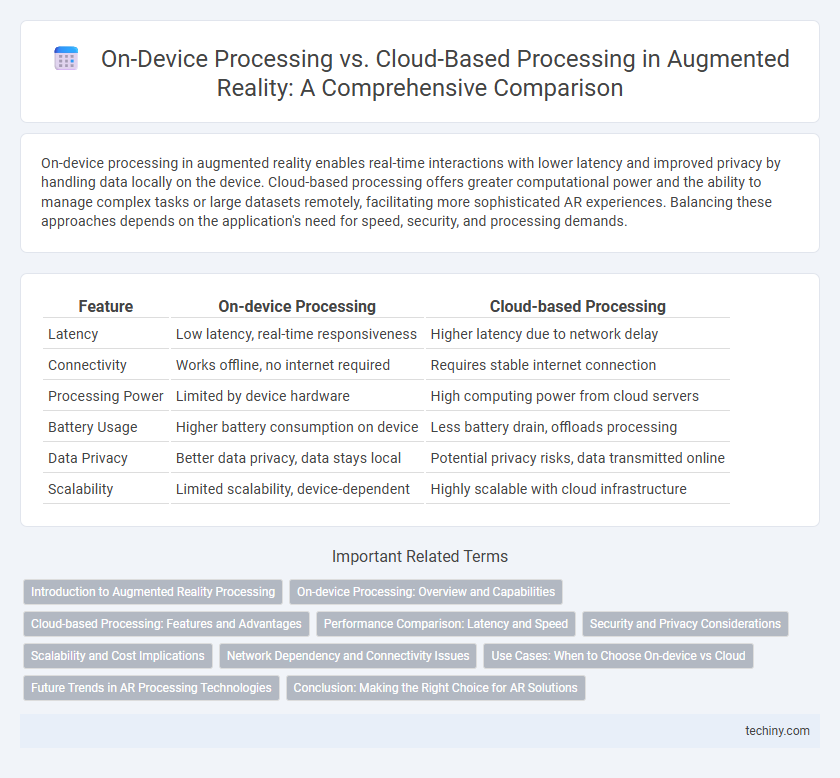On-device processing in augmented reality enables real-time interactions with lower latency and improved privacy by handling data locally on the device. Cloud-based processing offers greater computational power and the ability to manage complex tasks or large datasets remotely, facilitating more sophisticated AR experiences. Balancing these approaches depends on the application's need for speed, security, and processing demands.
Table of Comparison
| Feature | On-device Processing | Cloud-based Processing |
|---|---|---|
| Latency | Low latency, real-time responsiveness | Higher latency due to network delay |
| Connectivity | Works offline, no internet required | Requires stable internet connection |
| Processing Power | Limited by device hardware | High computing power from cloud servers |
| Battery Usage | Higher battery consumption on device | Less battery drain, offloads processing |
| Data Privacy | Better data privacy, data stays local | Potential privacy risks, data transmitted online |
| Scalability | Limited scalability, device-dependent | Highly scalable with cloud infrastructure |
Introduction to Augmented Reality Processing
On-device processing in augmented reality (AR) enables real-time data analysis and rendering by utilizing the device's hardware, reducing latency and enhancing user experience. Cloud-based processing leverages remote servers to handle complex computations and large datasets, supporting more resource-intensive AR applications with scalable performance. Balancing on-device and cloud-based processing optimizes AR functionality by combining immediate responsiveness with powerful data processing capabilities.
On-device Processing: Overview and Capabilities
On-device processing in augmented reality harnesses the power of local hardware such as smartphones, AR glasses, and edge devices to handle complex computations including real-time object recognition, spatial mapping, and sensor fusion. This approach reduces latency, enhances privacy by minimizing data transmission, and enables offline functionality, making AR experiences more seamless and reliable. Advanced processors like Apple's A-series chips and Qualcomm's Snapdragon XR platforms are pivotal in delivering efficient on-device AI inference and graphics rendering critical for immersive AR applications.
Cloud-based Processing: Features and Advantages
Cloud-based processing in augmented reality leverages powerful remote servers to handle complex computations, enabling enhanced graphics rendering and real-time data analysis without taxing local device resources. This approach supports scalable performance, seamless updates, and access to vast datasets, which improve accuracy and user experience. Cloud infrastructure also facilitates multi-user collaboration and persistent AR environments by synchronizing data across devices globally.
Performance Comparison: Latency and Speed
On-device processing in augmented reality significantly reduces latency by handling computations locally, enabling real-time interactions with minimal delay, typically under 20 milliseconds. In contrast, cloud-based processing can experience variable latency from 50 to 150 milliseconds due to network transmission and server response times, which may impact user experience in latency-sensitive applications. Speed in on-device AR is highly dependent on hardware capabilities like GPU and AI accelerators, while cloud processing offers scalable computational power but at the cost of increased data transfer time.
Security and Privacy Considerations
On-device processing in augmented reality enhances security and privacy by minimizing data transmission, thereby reducing exposure to potential cyber threats and unauthorized access. Cloud-based processing, while offering scalable resources and advanced analytics, increases risks due to data being transferred and stored off-device, making it more vulnerable to interception and breaches. Prioritizing on-device AR solutions ensures sensitive user information remains localized, supporting compliance with data protection regulations like GDPR and HIPAA.
Scalability and Cost Implications
On-device processing for augmented reality enables real-time data handling and reduces latency, but it demands high-performance hardware, limiting scalability and increasing upfront costs. Cloud-based processing offers virtually unlimited scalability by leveraging distributed computing resources, which can lower initial hardware expenses but may incur higher ongoing costs due to data transmission and cloud service fees. Cost implications vary as on-device solutions require investment in advanced devices, while cloud-based models depend on bandwidth and server usage, influencing overall deployment and operational expenses.
Network Dependency and Connectivity Issues
On-device processing in augmented reality significantly reduces network dependency by handling data locally, which ensures smoother performance and real-time responsiveness even in environments with poor or unstable internet connectivity. Cloud-based processing, while offering extensive computational power and storage, often suffers from latency and interruptions due to fluctuating network conditions, impacting the user experience. Optimizing AR applications for on-device processing mitigates connectivity issues, making it ideal for mobile or remote usage scenarios where consistent internet access is not guaranteed.
Use Cases: When to Choose On-device vs Cloud
On-device processing excels in AR applications requiring real-time responsiveness, such as gaming or interactive navigation, where low latency and offline functionality are critical. Cloud-based processing is ideal for complex data analysis and high-quality rendering in use cases like large-scale industrial simulations or collaborative AR environments demanding extensive computational power. Choosing between on-device and cloud depends on factors like network availability, latency tolerance, and processing complexity specific to the AR use case.
Future Trends in AR Processing Technologies
On-device processing in augmented reality is advancing with powerful AI chips enabling real-time, low-latency experiences without reliance on internet connectivity, crucial for privacy-sensitive applications. Cloud-based processing leverages scalable data centers and edge computing to handle complex computations and large datasets, enhancing AR visuals and interactivity for multi-user environments. Emerging trends indicate hybrid models combining on-device and cloud resources, optimizing performance, energy efficiency, and seamless user experience across diverse AR platforms.
Conclusion: Making the Right Choice for AR Solutions
On-device processing in augmented reality delivers low latency and enhanced privacy by handling data locally, making it ideal for real-time, interactive applications. Cloud-based processing offers scalable computing power and access to extensive datasets, suitable for complex AR tasks requiring heavy computation or large storage. Selecting the right approach depends on balancing performance demands, privacy considerations, and the specific use case of the AR solution.
On-device Processing vs Cloud-based Processing Infographic

 techiny.com
techiny.com